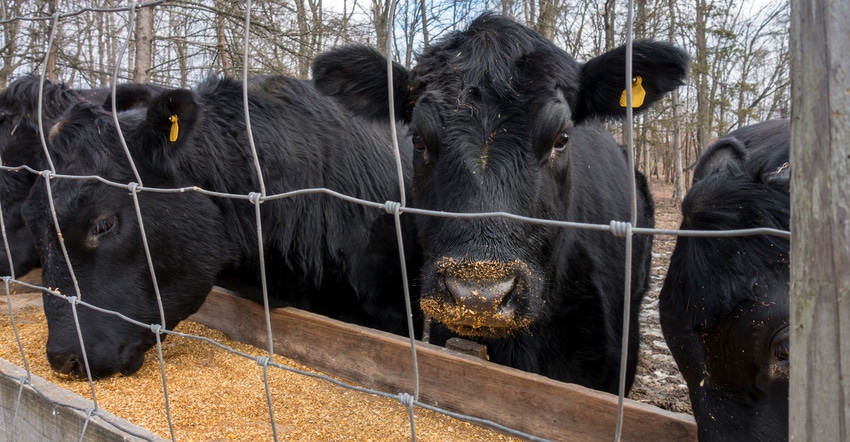
If you’re a cattle producer, you’ve felt the impact of high feed prices over the past eight months. However, it is not only the staples of corn and soybeans that are expensive, but other feedstuffs also are going up in price, and farmers need strategies for raising livestock with expensive feed costs.
Eric Bailey, University of Missouri Extension state beef specialist, said alternative feed choices such as pelleted soy hulls reached $170 per ton at the end of May. In locations like Indiana, the price of soy hulls during the first week in June reached $205 per ton.
“So, we’ve got a 50% increase in the price of a very common feedstuff that we use in supplements across Missouri and other states,” he explained during a recent MU Beef and Forage Town Hall. “We’re certainly starting to feel the pinch.”
During the recent MU town hall, Bailey shared insight not only on feed alternatives for the summer, but also how to prepare for winter since “feed costs are likely to remain high.”
Help for cow-calf producers
This spring has been good for pasture growth in much of Missouri’s cow-calf production regions. However, moving into the late summer and fall months requires more management to stave off supplemental feeding.
Bailey offered these tips for dealing with high feed costs in a cow-calf operation:
Cut the fat. Bailey said cow-calf beef producers should assess the overall body condition score of cows. Cattle should not be at a BCS of 6 or 7; he recommended a BCS of 5. “If you’re managing cows and they are staying literally town-dog fat year-round, that’s an opportunity where we can perhaps look at maybe trimming some of our supplement budget back,” he said. Farmers can reduce supplements and allow cows to lose a little condition during summer months.
Graze, but stockpile. This is a “really good” year to graze high-quality forages, Bailey said. However, he said cattle producers should look for ways to stockpile tall fescue and extend the grazing season into the winter months. Stockpiled forage can provide crude protein into February and March, and meet nutrient requirements for the dry, non-lactating pregnant cow. Stockpiling forage in late summer may help reduce feed costs in winter as farmers would not be forced to buy supplements.
While cow-calf producers may be able to keep feed costs in check with a few management practices, Bailey said the situation is more dire for cattle producers backgrounding or preconditioning calves.
Lower feed cost for backgrounders
The amount of money spent by farmers feeding calves has almost doubled when looking at what it takes to put on a pound of gain. So, it will take a combination of cheaper feed and increased feed efficiency to reduce feed costs. Bailey offered a few suggestions:
Buy in bulk. When at all possible, buying commodities in bulk rather than by the bag reduces feed costs.
Combine forage and feed. Consider feeding a single commodity paired with a higher-quality forage. It can be more cost-effective than offering a higher-priced ration with lower-quality forage. “Calves can put on pounds with good-quality forage,” Bailey added.
Feed ionophores. Bailey said that ionophores are one of the few products that offer a return up to $4 to $5 for every dollar spent. “When you feed the ionophores, you typically do see similar performance to maybe even a small increase in performance with 10% to 15% less feed,” he explained. “In a case like this where feed is really expensive, anything we can do that will help improve feed efficiencies is going to pay for itself.”
Alternative feeds. Bailey has created feed rations with burned soybeans, hominy and grain screenings. Farmers considering alternatives feeds should have a feed analysis done and get professional help, whether through MU Extension or a local feed nutritionist. If you are looking for alternative feeds, MU Extension offers a website listing byproducts and pricing.
No self-serve. Now is a time to limit or rid operations of creep or self-feeder options. Calves are not the only ones consuming the high-priced supplements. Farmers will see losses from wildlife consumption or even simple spillage. “Self-feeders given the prices of commodities right now does not make a lot of sense,” Bailey said.
Balance feed rations. Cattle producers should make sure there is at least 12.5% crude protein and 60% total digestible nutrients for growing calves.
Graze quality forage. This summer, putting on pounds can come from grazing high-quality forages. Bailey also noted that cattle producers may want to consider cost-share agreements this fall to graze cover crops. Many cover crops offer TDN in the 60s, he noted. “Forages are going to be the cheapest per unit of nutrients; these are going to be a low-hanging fruit in terms of putting weight gain on calves efficiently through the summer and into this fall.”
Calculate cost
When you make supplement decisions, comparison shop. Look at supplement costs on a price per pound of nutrient basis, like price per pound of TDN.
Bailey offered the table below as an example:

Bailey said farmers should look at the table and do the math based on prices in their local area as they will differ.
About the Author(s)
You May Also Like






